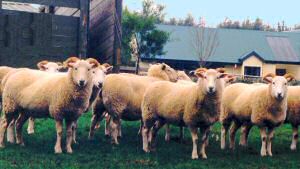|
STATUS New Zealand: Rare Importation: 1862, 1972 Overseas: Rare |
Wiltshire Horn Sheep
A Rare Breed of British Origin
 Wiltshire Horn rams at Ardo Farm (Photo courtesy John Morrison) |
The Wiltshire Horn is one of the oldest known British breeds but is now reduced to fewer than 300 animals in New Zealand. As its name implies, its most noticeable characteristic is its large horns.
Its clean face and legs feature a black nose and hoofs, while the fleece is markedly lighter and shorter with little wool around the tail area. A feature of the Wiltshire is that it sheds its fleece annually (an atavistic trait shown by some of our “feral” breeds).
The Wiltshire Horn was developed centuries ago on the dry, open, south-eastern downs of Wiltshire where it had to forage for herbage – and in so doing had to travel long distances, climb agilely, and endure extremes of climate, particularly the summer heat. These are characteristics it has not lost.
 Wiltshire Horn ewes at Utopia Farm (Photo by Jean Donaldson) |
A large sheep, it is essentially a meat producer. A Mr Herbert, writing in the British Farmer Magazine of 1830 reported that in 1788 he “… saw hanging in a butcher’s shop in London, three Wiltshire crocks (crooked) [so called from the shape of the horn] … the bare carcases of which [he notes they were wethers] averaged 33 stone 1 lb. each.” (That is 463 pounds or 210 kilograms – some sheep – especially if they were already dressed!!)
Professor Youatt in 1834 thought that “These Wiltshires have now passed quite away” having been replaced by or interbred with Southdowns. Fortunately he was wrong, although now the Wiltshire Horn is a rare breed in Britain as well as in New Zealand, though interestingly, they appear to be more common in Australia.
An intriguing item in the Nelson Examiner and New Zealand Chronicle of 12 May 1862, tells of Wiltshire Downs sheep being exhibited at the annual show of the Nelson Agricultural Association; they were “very fine animals” bred by a Mr Saxton from imported stock. However, this introduction was clearly not maintained.
What are today considered to be its most desirable features, especially its ability to forage, have been retained by the introduction of a Polled Wiltshire which carries polled Dorset and other genes, but this is essentially a mixed breed (see « Polled Wiltshire).
• » Breeders Directory listing •